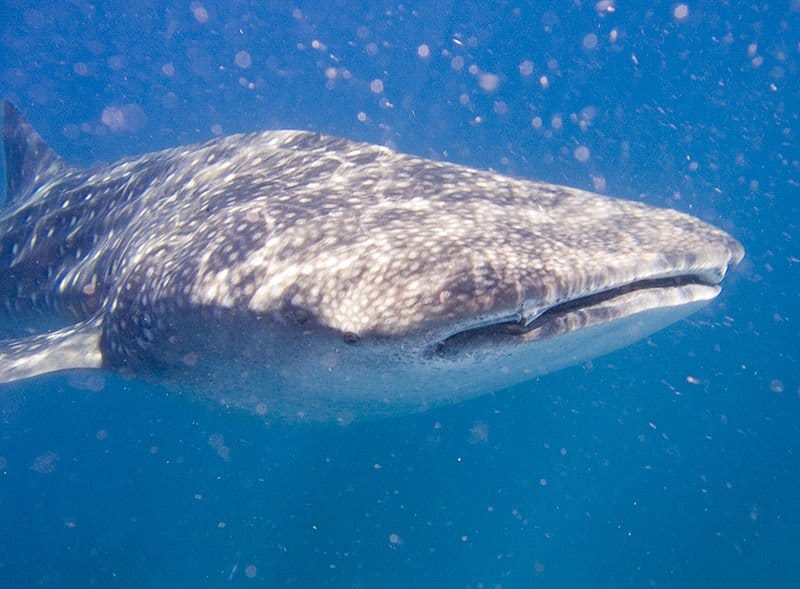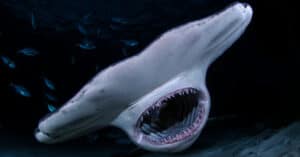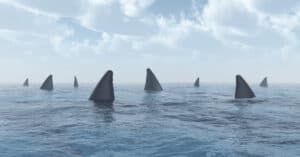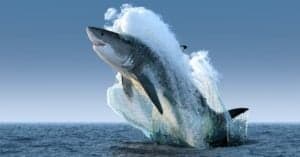What Do Sharks Eat? The Top 21 Foods in their Diets!
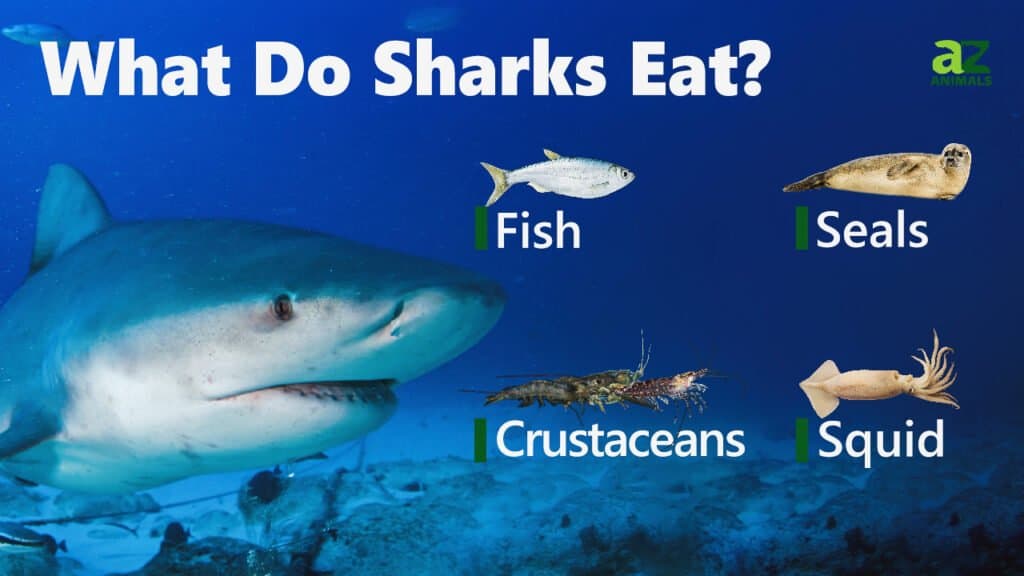
A-Z-Animals.com
Sharks are often portrayed in films as relentless hunters, but the truth is they eat everything from marine mammals to algae. But what is the favorite prey among different sharks? We’re diving into what sharks eat to determine 21 food sources that are the staples of their diets!
What Do Sharks Eat?
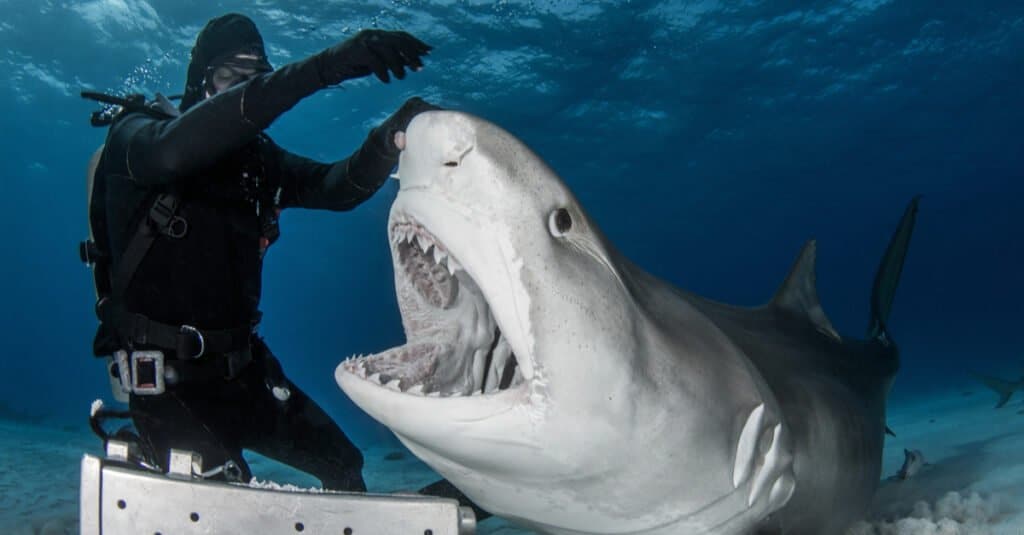
Tomas Kotouc/Shutterstock.com
Sharks are a fierce group of predators with surprisingly diverse diets. There are more than 500 different species of sharks within the Elasmobranchii subclass, with more being discovered all the time. These species are grouped into 30 families based on their body shapes, sizes, diets, and many other defining characteristics.
Although they are a diverse group of animals, sharks tend to have one of just two main types of diets. All known species of sharks are either carnivorous, meaning they mostly eat larger marine animals such as fish, seals, and turtles, or planktivorous, meaning they feed primarily on tiny species of plankton.
Many species of sharks are also apex predators, meaning they have no real competition for food and are at the top of their food chain. Apex predator sharks have a hugely varied smorgasbord of different types of animals they can choose to feed upon, but it’s important to note that not all sharks are fierce, carnivorous opportunists. Some species, such as whale sharks and basking sharks, peacefully filter feed on plankton and little else.
What Do Carnivorous Sharks Eat?

The majority of shark species are carnivores and will eat just about any ocean animals small or weak enough to get into their sharp-toothed mouths. These meat-eating sharks are extremely skilled hunters and usually have little to no competition when it comes to what they eat.
Although they usually don’t have to compete with anyone for their food, carnivorous sharks aren’t very finicky eaters. Some of the many types of animals they eat include the following:
- Bony fishes of varying sizes, from sardines and anchovies to tuna and mackerel
- Crustaceans
- Mollusks
- Seals
- Squid
- Octopus
- Rays
- Turtles
- Dolphins
- Sea urchins
Smaller species of carnivorous sharks, like the pygmy shark, tend to eat smaller prey like small bony fishes, squid, and shrimp, while larger species will regularly consume more substantial animals like seals, turtles, and sea lions.
For example, detailed analysis of mostly juvenile scalloped hammerheads found that their favorite prey was smaller squid species. Meanwhile a study of what tiger sharks ate found their favored prey was larger species like marine mammals and rays and skates.
Some sharks, such as the bull shark, will even resort to eating smaller sharks when food gets scarce, though this is rare.
How Do Carnivorous Sharks Hunt Their Prey?

Maui Topical Images/Shutterstock.com
Carnivorous sharks’ bodies are designed perfectly for efficiently and stealthily hunting their prey. They are known to use a variety of strategies depending on their size, species, and the prey animal they are hunting, from simply swallowing them whole to ripping them apart with their large mouths full of rows and rows of razor-sharp teeth.
Since carnivorous sharks prefer eating live flesh, they consume their prey immediately. When stalking larger prey animals like turtles and dolphins, they will hunt in packs, ensuring every bit of the animal they take down is consumed.
Amazingly, many species of sharks can go as long as a month or more without a meal, making them very resilient animals that rarely die of starvation. Fortunately, carnivorous sharks are among the most adept hunters in the ocean and usually have an abundance of prey animals to choose from, so food scarcity usually isn’t an issue for them.
What Do Planktivorous Sharks Eat?
The other main group of sharks are planktivorous, meaning rather than hunting and eating large prey like turtles and dolphins, they survive solely on tiny species of plankton. There are only three species of planktivorous sharks: the basking shark, the whale shark, and the megamouth shark.
The main types of plankton these sharks eat consist of two main groups, phytoplankton and zooplankton. Both types are very small, with phytoplankton being the smaller of the two and microscopic, thus invisible to the naked eye. These groups of plankton are made up of the following animals, all of which are eaten by planktivorous sharks in large amounts:
- Small copepods and their larvae
- Various species of shrimp
- Algae
- Decapod larvae, i.e. crab, lobster, and shrimp larvae
- Krill
- Barnacles
Additionally, these sharks will occasionally eat other small marine animals such as:
- Squid
- Fish eggs
- Small species of baitfish
- Jellyfish
- Mollusks
How Do Planktivorous Sharks Eat?
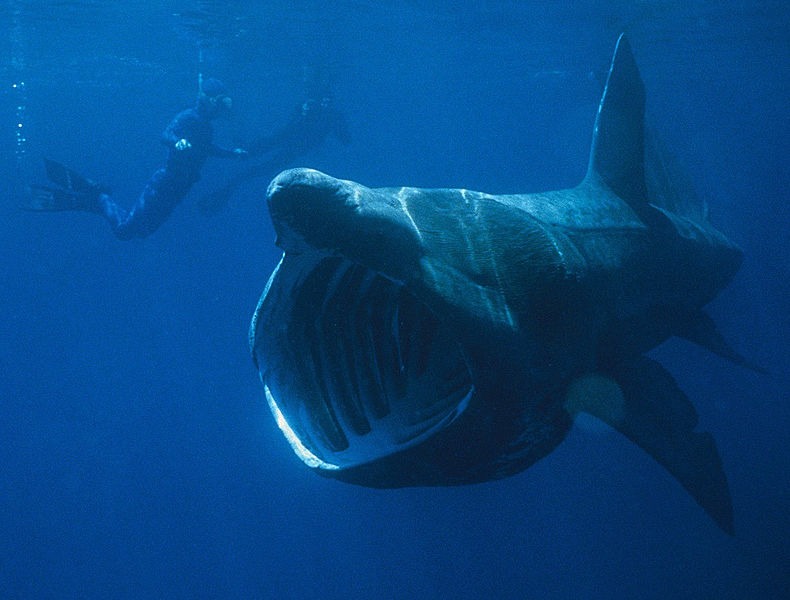
Chris Gotschalk / Public Domain
The three known species of planktivorous sharks eat passively, floating slowly through the ocean and using unique structures known as gill rakers sort of as suction filters. Interestingly, they function similarly to how baleen whales use their baleen plates to pull in tiny marine animals and large amounts of water.
Gill rakers are made of cartilage and are long, thin, comb-like structures in the place of teeth. Planktivorous sharks such as the basking shark suck water into their mouths, pulling in lots of tiny plankton and other animals in the process, which get trapped in the “teeth” of the comb-like gill rakers. After filtering out the water over their gills, planktivorous sharks then eat the leftover animals trapped in their gill rakers.
A 2015 study found that whale sharks tend to hunt and feed on plankton in groups of anywhere from two or three to as many as 20 or more individuals! They prefer feeding on very large and dense groups of plankton to conserve energy.
More from A-Z Animals

A-Z-Animals.com
Sharks are often portrayed in films as relentless hunters, but the truth is they eat everything from marine mammals to algae. But what is the favorite prey among different sharks? We’re diving into what sharks eat to determine 21 food sources that are the staples of their diets!
What Do Sharks Eat?

Tomas Kotouc/Shutterstock.com
Sharks are a fierce group of predators with surprisingly diverse diets. There are more than 500 different species of sharks within the Elasmobranchii subclass, with more being discovered all the time. These species are grouped into 30 families based on their body shapes, sizes, diets, and many other defining characteristics.
Although they are a diverse group of animals, sharks tend to have one of just two main types of diets. All known species of sharks are either carnivorous, meaning they mostly eat larger marine animals such as fish, seals, and turtles, or planktivorous, meaning they feed primarily on tiny species of plankton.
Many species of sharks are also apex predators, meaning they have no real competition for food and are at the top of their food chain. Apex predator sharks have a hugely varied smorgasbord of different types of animals they can choose to feed upon, but it’s important to note that not all sharks are fierce, carnivorous opportunists. Some species, such as whale sharks and basking sharks, peacefully filter feed on plankton and little else.
What Do Carnivorous Sharks Eat?

The majority of shark species are carnivores and will eat just about any ocean animals small or weak enough to get into their sharp-toothed mouths. These meat-eating sharks are extremely skilled hunters and usually have little to no competition when it comes to what they eat.
Although they usually don’t have to compete with anyone for their food, carnivorous sharks aren’t very finicky eaters. Some of the many types of animals they eat include the following:
- Bony fishes of varying sizes, from sardines and anchovies to tuna and mackerel
- Crustaceans
- Mollusks
- Seals
- Squid
- Octopus
- Rays
- Turtles
- Dolphins
- Sea urchins
Smaller species of carnivorous sharks, like the pygmy shark, tend to eat smaller prey like small bony fishes, squid, and shrimp, while larger species will regularly consume more substantial animals like seals, turtles, and sea lions.
For example, detailed analysis of mostly juvenile scalloped hammerheads found that their favorite prey was smaller squid species. Meanwhile a study of what tiger sharks ate found their favored prey was larger species like marine mammals and rays and skates.
Some sharks, such as the bull shark, will even resort to eating smaller sharks when food gets scarce, though this is rare.
How Do Carnivorous Sharks Hunt Their Prey?

Maui Topical Images/Shutterstock.com
Carnivorous sharks’ bodies are designed perfectly for efficiently and stealthily hunting their prey. They are known to use a variety of strategies depending on their size, species, and the prey animal they are hunting, from simply swallowing them whole to ripping them apart with their large mouths full of rows and rows of razor-sharp teeth.
Since carnivorous sharks prefer eating live flesh, they consume their prey immediately. When stalking larger prey animals like turtles and dolphins, they will hunt in packs, ensuring every bit of the animal they take down is consumed.
Amazingly, many species of sharks can go as long as a month or more without a meal, making them very resilient animals that rarely die of starvation. Fortunately, carnivorous sharks are among the most adept hunters in the ocean and usually have an abundance of prey animals to choose from, so food scarcity usually isn’t an issue for them.
What Do Planktivorous Sharks Eat?
The other main group of sharks are planktivorous, meaning rather than hunting and eating large prey like turtles and dolphins, they survive solely on tiny species of plankton. There are only three species of planktivorous sharks: the basking shark, the whale shark, and the megamouth shark.
The main types of plankton these sharks eat consist of two main groups, phytoplankton and zooplankton. Both types are very small, with phytoplankton being the smaller of the two and microscopic, thus invisible to the naked eye. These groups of plankton are made up of the following animals, all of which are eaten by planktivorous sharks in large amounts:
- Small copepods and their larvae
- Various species of shrimp
- Algae
- Decapod larvae, i.e. crab, lobster, and shrimp larvae
- Krill
- Barnacles
Additionally, these sharks will occasionally eat other small marine animals such as:
- Squid
- Fish eggs
- Small species of baitfish
- Jellyfish
- Mollusks
How Do Planktivorous Sharks Eat?

Chris Gotschalk / Public Domain
The three known species of planktivorous sharks eat passively, floating slowly through the ocean and using unique structures known as gill rakers sort of as suction filters. Interestingly, they function similarly to how baleen whales use their baleen plates to pull in tiny marine animals and large amounts of water.
Gill rakers are made of cartilage and are long, thin, comb-like structures in the place of teeth. Planktivorous sharks such as the basking shark suck water into their mouths, pulling in lots of tiny plankton and other animals in the process, which get trapped in the “teeth” of the comb-like gill rakers. After filtering out the water over their gills, planktivorous sharks then eat the leftover animals trapped in their gill rakers.
A 2015 study found that whale sharks tend to hunt and feed on plankton in groups of anywhere from two or three to as many as 20 or more individuals! They prefer feeding on very large and dense groups of plankton to conserve energy.

